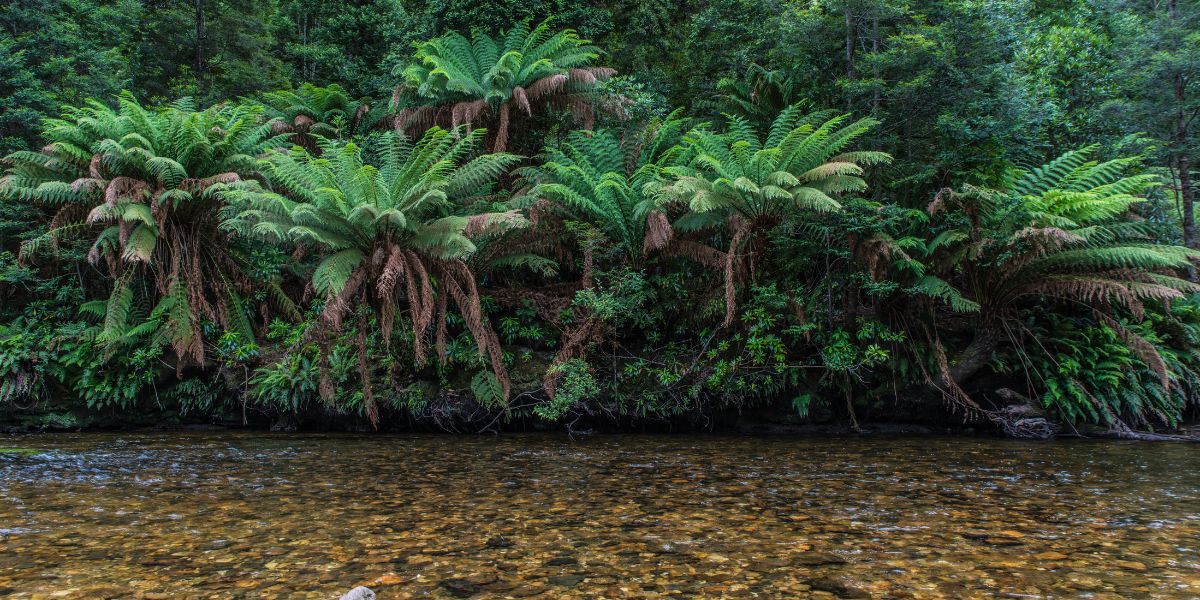Using the past to inform sustainable policies for the future
Innovative analysis of paleoclimate data from the last thousand years is informing better environmental management. What more can governments do to harness this valuable natural record to improve policymaking?
Philippa Higgins, Chris Turney, Jonathan Palmer, Tristan Derham, Lucinda Duxbury and Matthew Fielding

27 August 2024
Australia’s natural disasters – such as the 2017-19 drought and 2022-23 floods – are becoming more frequent, costly and dangerous. Like in all other parts of the world and despite substantial recent investment in climate mitigation, this is only expected to accelerate. A critical problem in understanding this trend is the brevity of our climate records, severely hampering risk predictions. Fortunately, paleoclimate data extends the historic record back hundreds of years, providing an invaluable resource to inform policy and how we manage a rapidly changing environment.
Australia has one of the world’s most variable climates, experiencing numerous droughts and floods over the past century. These events take a significant environmental and economic toll. For example, droughts and bushfires between 2017 and 2020 cost almost $63 billion and destroyed 18.6 million hectares of land. Natural disasters also have catastrophic social and mental health effects on communities.
Planning for an uncertain future in a changing climate is complex. We have a reasonable understanding of increasing temperatures and the impact on the ground. Whilst the severity of hydroclimate conditions is also rising worldwide, local factors affect how different regions experience extremes in water availability. The warming atmosphere makes rainfall more intense and worsens floods, but these kinds of disasters remain notoriously hard to predict and plan for.
However, climate change does not tell the whole story. Australia has always experienced droughts and floods. Extreme events are often thought of as unforeseeable disasters when in fact their occurrence is a typical feature of the Australian landscape. Climate change amplifies our already variable climate, increasing the risk of natural disasters.
To future-proof environmental policy, we must understand the scale of extreme climate events and how often they might occur.
One of our biggest challenges is that records from modern instrumental measurements – rainfall, temperature and streamflow gauges – are too short to give us a complete picture of climate variations, especially for rare but potentially devastating events.
Understanding climate variability with only a few decades of weather data is like trying to predict a grand final winner by watching only the last few matches. On the other hand, paleoclimate scientists review the entire “career” of the Earth’s climate, analysing tree rings, ice cores and sediments to understand climate patterns over hundreds to thousands of years, much like a sports analyst studying years of game footage. First Nations people saw the importance of keeping long-term records of climate extremes on this continent, passing down memories documenting drastic sea level rise and volcanic eruptions from thousands of years ago.
Palaeoclimate data can provide a long record of climate variations, revealing the vital long-term context to better understand “extreme” recent events. This is crucial for making informed policy decisions about managing water resources, planning our cities or identifying places that could serve as safe havens for plants and animals during future extreme events.
Water management through a palaeo lens
Basing policy decisions on insufficient data can be disastrous for the environment. In the early 1920s in the United States, the Colorado River Compact divvied up rights to the river water between seven basin states. Water allocations were based on 20 years of streamflow measurements. Unfortunately, those 20 years were unusually wet. In fact, paleoclimate data shows it was one of the wettest periods in the last 1,000 years. The impacts of the overallocation of the Colorado River continue to challenge water managers, farmers and communities.
While the Colorado River serves as a cautionary tale, there are also success stories. Palaeoclimate data has been pivotal in improving water management practices in the western United States. Tree ring scientists identified that past droughts in the Salt River basin were much more prolonged than instrumental period droughts. Working together with water managers, they changed the operation of reservoir levels to account for longer droughts, better protecting the environment and community from water shortages during future dry periods.
Until now, Australian water managers have lagged behind other countries in adopting the palaeo-data approach, but things are starting to change. Just recently, the NSW Government adopted a water planning strategy incorporating palaeoclimate data to understand climate risk when making new infrastructure and planning decisions. Similarly, Southeast Queensland Water is working with scientists to integrate palaeo data into risk assessments for dam inflows. These case studies represent an encouraging step towards systematically integrating palaeo data into climate risk planning in Australia.
Expanding palaeo data applications
Recently, palaeo research has witnessed transformative advancements, primarily through database compilation, specialised software tools and improved modelling methods. These have enriched the methodological rigour of palaeo data analysis and expanded its applications in environmental management.
Palaeo data is being used to balance different ecological and social objectives in environmental management and to inform discussions about ecological benchmarks. For instance, palaeoclimate research has been used to develop water quality targets for Chesapeake Bay and in the management and conservation of wetlands in the United Kingdom. In these examples, long-term data on how ecosystems functioned before human interference provides policymakers with the scientific evidence base for restoration targets.
We see a huge potential for integrating palaeoclimate data in natural resource decision-making in Australia, particularly for biodiversity conservation. For instance, the Coffs Harbour region – known for its World Heritage-listed Gondwanan rainforests and rich ecology – has been drought-free for the past century, serving as a crucial refuge for native species. However, paleo data reveals that, over the last 500 years, this region has regularly faced severe droughts. If we ignore this more extended dataset, we can underestimate the risk of future droughts and miss the opportunity to proactively protect this natural treasure.
Palaeo data allows us to determine the average time between extreme events, which can be used to set guardrails for developing resilient infrastructure, designate refugia for biodiversity and shape sustainable water resource policies. It is about looking beyond the immediate past and understanding the full scope of what history can teach us, ensuring that our environmental policies are well-rounded and forward-thinking.
Bringing palaeo data into public policy
While there is substantial potential for using palaeo data to drive more informed environmental policies in Australia, multiple barriers remain to its wider adoption.
Historically, palaeoclimate research has rarely focused on generating data to inform policies. Improving data availability, reliability and resolution are ongoing technical challenges. Some regions currently lack sufficient palaeo records to usefully guide policy decisions. We need more investment in data collection and analysis to fill gaps in these data-poor regions.
For relatively data-rich regions, we must do more to disseminate palaeoclimate research beyond peer-reviewed journal articles. We need new tools to translate data stored in databases to forms that specifically target the practical needs of policymakers.
The success stories from the United States and some examples from Australia indicate a way forward. Lessons learned from decades of palaeo policy integration underscore that bridging this gap will require effort from both scientists and policymakers. On one side, there is a clear need for the science community to translate findings into formats that are accessible and relevant to the natural-resource-management community. Policymakers should have access to both pertinent information and expert support to understand the data, its potential applications and its limitations.
Conversely, decision-makers need to be willing to engage with new types of data and policy insights that derive from it. The primary aim of palaeoclimate data is to inform future decisions based on long-term evidence. Decision-makers must recognise palaeo data as a tool for forward-planning and therefore support long-term investment in collecting new datasets. An interactive dialogue between researchers and natural resource managers can enhance the inclusion of palaeoclimate data to inform management.
Natural archives can provide the long-term perspective to further inform Australia’s environmental policy and planning. To effectively address climate change, we must examine the fuller range of climate extremes captured by palaeo data rather than limiting our focus to just the past century. We advise that integrating insights from palaeoclimate trends, wherever accessible, should be standard practice in planning and policy.
Dr Philippa Higgins is a researcher at the Water Research Centre at the University of New South Wales working on paleoclimate reconstruction for water resource management. Her research focuses on long-term climate variability using tree-ring proxies, addressing the challenges of hydroclimatic assessment in regions like eastern Australia and the South Pacific Islands
Professor Chris Turney is the Pro Vice-Chancellor (Research) at the University of Technology Sydney, a Professor of Climate and Earth Science, and a Board Director for the NSW Environment Protection Authority (the EPA). He works towards partnering academia with industry, government, and communities, to achieve far-reaching positive impacts and accelerate the transition to a circular economy and sustainable future.
Dr Jonathan Palmer is a researcher at UNSW’s School of Biological and Earth and Environmental Sciences. He specialises in tree-ring applications for reconstruction and analysis of climate variability and change. Jonathan has developed more than 150 sites over a diverse range of environments from Pakistan to the subantarctic Campbell Island.
Dr Tristan Derham is a lecturer in Biological Sciences at the University of Tasmania. His academic interests lie at the nexus of environmental philosophy, ecology and the relationships between people and the environment. In his previous role, Tristan worked to facilitate academic policy engagement, as well as directly investigating policy issues such as conservation translocations and rewilding.
Lucinda Duxbury is a PhD student at the University of Tasmania, researching the intersection of geochemistry, genetics and climate science. She studies ancient DNA and RNA to identify the organisms that once lived on the sea floor and ocean, reconstruct past ecosystems, and link changes to the marine food web with rapid ice melt in the past.
Dr Matthew Fielding is a Teaching Fellow at the University of Tasmania. Matthew is an ecologist with an interest in human-wildlife interactions and a passion for effective science communication. He believes being able to communicate scientific research to any audience is essential to see impact.
Image credit: Gpoint Studio
Features
Libby Hackett, Jordan Ward, Jack Isherwood, Bonnie Bley, Hannah Lobb, Isabella Whealing and Hugh Piper
Subscribe to The Policymaker
Explore more articles
Cristy Brooks, Amelia Mardon and Mike Armour
Features
George (Kev) Dertadian
Explore more articles
Cristy Brooks, Amelia Mardon and Mike Armour
Subscribe to The Policymaker












